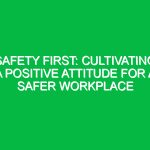Introduction
The concept of a “hazard person called” might sound like jargon to some, but it holds significant relevance in the domain of Health, Safety, and Environment (HSE). In essence, this term refers to the designated individual responsible for managing and responding to hazards within a workplace or operational setting. This role is crucial for ensuring the safety of employees and the environment, making it a fundamental aspect of HSE strategies today. As industries evolve and safety regulations become more stringent, understanding the responsibilities and significance of the hazard person called can bolster organizational safety protocols and foster a culture of proactive hazard management.
Understanding the Role of Hazard Person Called
The hazard person called serves as a pivotal link in an organization’s safety management system. Their primary responsibilities include identifying potential hazards, assessing risks, and implementing control measures to mitigate those risks. This role often involves collaboration with various departments to ensure a holistic approach to safety.
Key Responsibilities
- Hazard Identification: The first step in any safety protocol is recognizing what hazards exist. This could range from chemical spills in manufacturing to ergonomic risks in an office setting.
- Risk Assessment: Once hazards are identified, assessing the level of risk they pose is crucial. This involves evaluating the likelihood of an incident occurring and its potential impact.
- Mitigation Strategies: Implementing strategies to reduce or eliminate risks is a central duty. This might include training staff, enhancing safety equipment, or redesigning workspaces.
- Emergency Response: The hazard person called must be prepared for emergencies. They are often responsible for creating and executing emergency response plans.
- Training and Communication: Ensuring that all employees are aware of potential hazards and understand safety protocols is vital for creating a safe work environment.
Why a Designated Hazard Person is Essential
The presence of a dedicated hazard person can significantly enhance workplace safety. For instance, in a manufacturing plant, the risk of accidents can increase due to machinery and hazardous materials. A hazard person who is vigilant and knowledgeable can prevent potential disasters by ensuring that all safety measures are adhered to. In a real-world case, a steel manufacturing company saw a 30% reduction in workplace incidents after appointing a qualified safety officer to oversee hazard management. This emphasizes the importance of having someone focused solely on safety.
Hazard Identification and Risk Assessment
Central to the role of the hazard person called is the process of hazard identification and risk assessment. This involves meticulous evaluation and documentation of potential hazards that could affect employees and the environment.
Effective Hazard Identification Techniques
- Workplace Inspections: Regular inspections help identify hazards that may not be apparent during typical operations.
- Employee Feedback: Engaging employees in discussions about safety can uncover potential hazards that management might overlook.
- Incident Reports: Analyzing past incidents can provide insights into hazards that need to be addressed.
- Safety Audits: Conducting audits against established safety standards can reveal compliance gaps and potential hazards.
Conducting Risk Assessments
Once hazards are identified, the next crucial step is risk assessment. This process involves evaluating the likelihood of an incident occurring and its potential consequences. It’s essential to prioritize risks based on their severity and likelihood. A straightforward approach is to use a risk matrix, which categorizes risks into levels such as low, medium, and high. By focusing on high-risk areas, organizations can allocate resources effectively and implement targeted safety measures.
Best Practices for Hazard Management
Implementing best practices in hazard management not only protects employees but also enhances overall operational efficiency. Here are some strategies that can be adopted:
1. Foster a Safety Culture
Encouraging a culture of safety within the organization is paramount. Employees should feel empowered to report hazards without fear of repercussions. This openness can lead to quicker identification and resolution of safety concerns.
2. Regular Training Programs
Training should be ongoing, not just a one-time event. Regular refresher courses can help keep safety protocols top-of-mind for all employees. Additionally, role-playing emergency scenarios can prepare staff for real-life situations.
3. Utilize Technology
Advancements in technology can greatly enhance hazard management. Utilizing apps for reporting hazards or implementing safety management software can streamline processes and improve communication.
Potential Hazards and Safety Considerations
Every workplace has unique hazards, and the hazard person called must be adept at recognizing these. Common hazards include:
- Chemical Hazards: Exposure to harmful substances can occur in various industries, necessitating proper labeling and storage protocols.
- Physical Hazards: These include machinery, slips, trips, and falls, which can be mitigated through proper training and equipment.
- Ergonomic Hazards: Poor workstation setup can lead to musculoskeletal disorders, making ergonomic assessments essential.
- Biological Hazards: In sectors like healthcare, exposure to viruses and bacteria can pose significant risks.
Addressing Safety Considerations
Each type of hazard requires specific safety considerations. For instance, chemical hazards demand comprehensive Material Safety Data Sheets (MSDS) and proper personal protective equipment (PPE). Conversely, ergonomic hazards might necessitate workstation adjustments and training on safe work practices. The hazard person called must have a thorough understanding of each type of hazard and the best practices for managing them.
Regulations and Standards Impacting Hazard Person Called
In many countries, regulations govern occupational health and safety, influencing the responsibilities of the hazard person called. For instance, in the United States, the Occupational Safety and Health Administration (OSHA) sets forth regulations requiring employers to maintain a safe workplace. Similarly, the Health and Safety Executive (HSE) in the UK enforces regulations covering a wide range of industries.
Compliance with Regulations
Compliance with these regulations is essential not only for legal reasons but also for fostering a safe workplace. The hazard person called should be well-versed in the relevant laws and ensure that the organization meets all compliance requirements. Regular audits and assessments can help maintain compliance, avoiding penalties and promoting safety.
International Standards
Beyond national regulations, international standards such as ISO 45001 provide a framework for occupational health and safety management systems. Aligning with these standards can enhance an organization’s reputation and commitment to safety.
Conclusion
The role of the hazard person called is integral to the success of health, safety, and environmental management systems. By effectively identifying hazards, assessing risks, and implementing best practices, organizations can create safer work environments. As industries continue to evolve, prioritizing safety through dedicated roles like the hazard person called will not only comply with regulations but also promote a culture of safety that can lead to reduced incidents and enhanced employee well-being. Ultimately, organizations must recognize that investing in safety is an investment in their most valuable asset: their people. For those looking to enhance their safety protocols, revisiting the role of the hazard person called is a vital step toward achieving a safer and more sustainable workplace.


